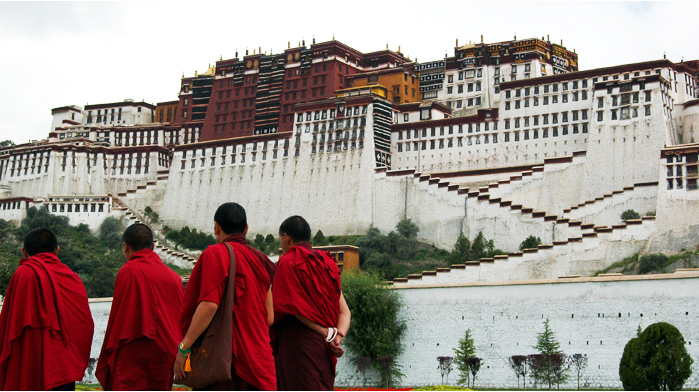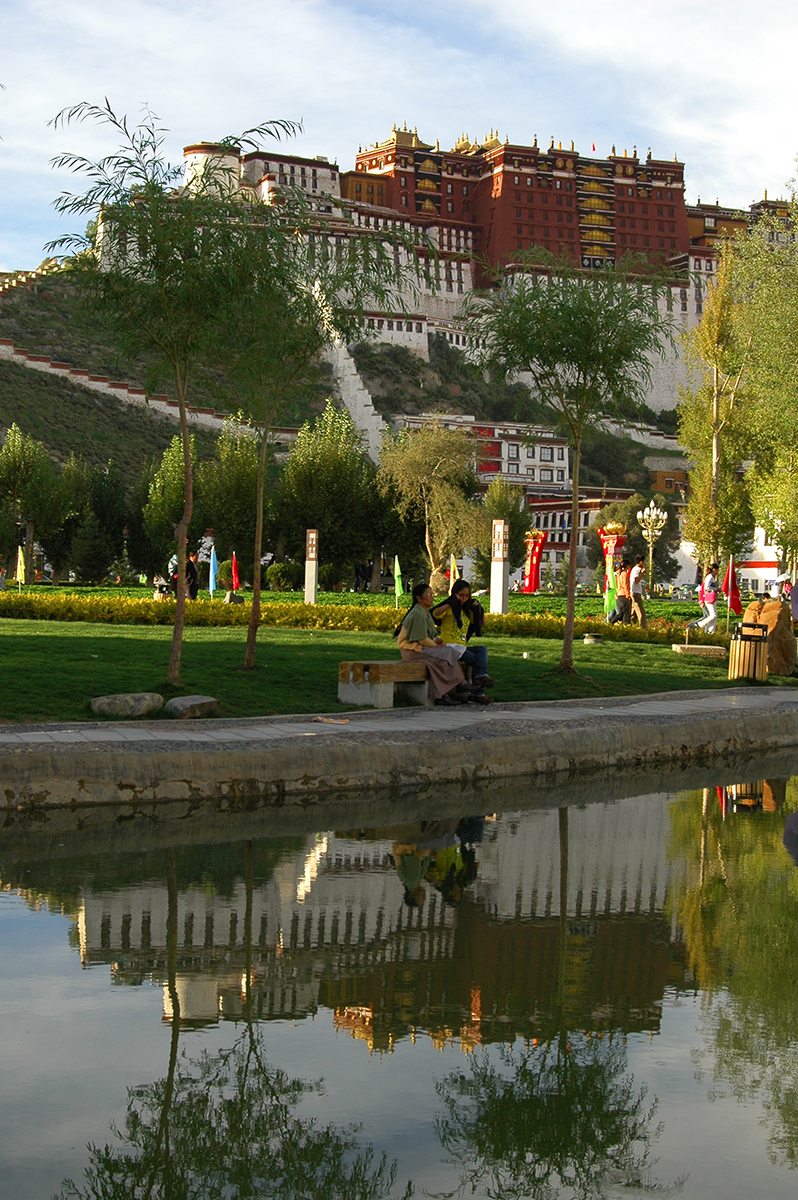
Rising majestically atop the Marpori or Red Mountain at an altitude of 3,750 metres (12,300 ft.), the Potala Palace ranks as the highest ancient palace in the world. Towering 100 metres (300 ft.) above the city of Lhasa, it simply can’t be missed, and represents one of the most breath-taking sights in a city resplendent with the finest architecture Tibet has to offer. Its historical significance as both a political and religious icon in Tibet meant it was designated a UNESCO World Heritage Site in 1994. If you’re making the dizzying climb to the Roof of the World, a visit to the Potala Palace should be virtually compulsory.
The palace’s spiritual importance is embodied in its name, which is derived from Mount Potalaka, the legendary abode of the Buddhist bodhisattva[1] Avalokiteśvara. In fact, the palace itself rests on one of three main hills known as the “Three Protectors of Tibet”: Chokpori Mountain, which represents the bodhisattva Vajrapani; Pongwari Mountain, which signifies Manjusri; and Marpori Mountain, which symbolises Avalokiteśvara. Located on a prime piece of spiritual real estate, it was practically destined to be a sacred site!
The palace was initially constructed in 637 by Songtsän Gampo, the first ruler of the Tibetan Empire (618–842). Tragically, when the Tibetan Empire collapsed, the palace was destroyed during the ensuing civil wars. It remained in ruins until the 17th century, when the 5th Dalai Lama, Ngawang Lobsang Gyatso, unified Tibet and became its independent leader. When the 5th Dalai Lama moved his capital to Lhasa, a spiritual adviser named Konchog Chophel pointed out that the site of the previous Potala Palace would make an ideal seat of government, since its elevated position offered it protection and it was situated near to the Buddhist monasteries of Drepung and Sera.

In 1645, construction of the present palace began and, within three years, the White Palace had been completed. From 1690 to 1694, it was expanded to include the magnificent Red Palace. Overall, over 7,000 labourers and 1,500 artisans were required to complete this mammoth task! The end result was a glorious 13-storey high palace encompassing over 1,000 rooms and decorated with countless murals, painted scrolls, sculptures, statues, porcelain wares, intricately woven carpets, silk curtains, and fine objects of silver and gold. However, don’t be fooled into thinking the Potala Palace is just a pretty face! Its libraries contain a boundless collection of valuable sutras[2] and historical documents.
In the northwest corner, you’ll find two chapels that preserve parts of Songtsän Gampo’s original palace. These are the Saint’s Chapel and the Dharma Cave, both regarded as some of the holiest sites in the palace. The Saint’s Chapel contains a glittering jewel encrusted statue of Avalokiteśvara and an ominous dark passageway that leads to the Dharma Cave, where Songtsän Gampo himself supposedly meditated and pursued his study of Buddhism. This sacred cave is bedecked with images of Songtsän Gampo, along with his wives, Princess Bhrikuti of the Nepalese Licchavi Kingdom (c. 400–750 AD) and Princess Wencheng of the Han Chinese Tang Dynasty (618-907).
The White Palace, made up of the two white-washed wings on either side of the crimson Red Palace, once served as the seat of the Tibetan government and the main residence of the Dalai Lama. From the 18th century onwards, it was used only as a winter palace, as the newly built Norbulingka functioned as the summer palace. If the White Palace represented the political element of the Potala Palace, then the Red Palace was its spiritual core.
A central, yellow-painted courtyard separates the living quarters of the White Palace from the Red Palace, which was completely devoted to religious study and prayer. It houses numerous chapels, shrines, and sacred statues, but its most prized articles are undoubtedly the tombs of eight Dalai Lamas. For this reason, it remains a pilgrimage site of unparalleled importance to Tibetan Buddhists. Each of the tombs is encased in a sacred golden stupa[3], inlaid with glittering jewels and smooth gemstones.
The most impressive of these is undeniably the tomb of the 5th Dalai Lama, which is over 14 metres (49 ft.) in height. To put that into perspective, it’s nearly five times the size of an African elephant! Sparkling in the pale morning light, the tomb is gilded entirely in gold and studded with over 18,000 jewels, including diamonds, pearls, and a myriad of other precious gems. Faced with such a colossal treasure, you might find it a little harder to channel your inner monk and loosen your attachment to material things!
Notes:
[1] Bodhisattva: The term literally means “one whose goal is awakening”. It refers to a person who seeks enlightenment and is thus on the path to becoming a Buddha. It can be applied to anyone, from a newly inducted Buddhist to a veteran or “celestial” bodhisattva who has achieved supernatural powers through their training.
[2] Sutra: One of the sermons of the historical Buddha.
[3] Stupa: A hemispherical structure with a small interior designed for storing Buddhist relics and for private meditation.
Make your dream trip to the Potala Palace come true on our travel: Explore Untouched Wilderness on Our Full Circuit of Tibet